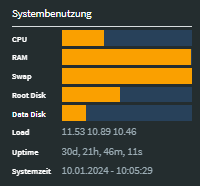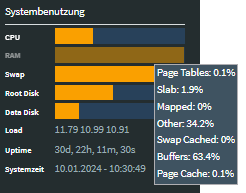Collax Virtualisation: Understanding RAM usage and disk caching
11.01.2024
Stefan Kaysersberg
Stefan Kaysersberg
The handling of RAM and buffers in a Collax virtualisation and high availability server can sometimes raise questions. In particular, reserving unused memory for the hard disk cache can give the impression of a scarce RAM situation. This article clarifies and explains the advantages of this approach.
Initial situation
Analysing the system usage reveals a specific scenario. A look at the resource utilisation shows that the RAM bar is fully utilised. Hovering the mouse over the bar provides particularly revealing information on the value under “Buffers”.


Explanation
Collax reserves unused memory for the hard disk cache, which makes the system faster and more responsive without taking memory away from virtual machines. If they need more memory, they can easily reclaim a portion that the hard disk cache has temporarily borrowed. The cache can be immediately returned to applications at any time, so there is no RAM shortage.
Conclusion
In summary, it can be said that the apparent full utilisation of the RAM is due to the use of unused memory for the hard disk cache. This approach significantly improves system performance without creating disadvantages for running applications. If they require additional memory, they can easily reclaim some of the memory borrowed from the hard disk cache. The flexibility of this approach allows optimal utilisation of the available RAM and there is no need to worry about running out of memory.
You can find more information about our virtualisation and high availability solutions and their wide range of applications on the product page Virtualisation and high availability.
